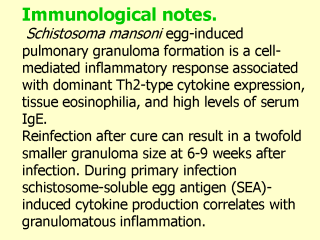 |
Cytokine
levels peaked during the acute infection, declined with chronic infection and become
undetectable after treatment. Reinfection after treatment stimulated a two- to three-fold
increase in SEA-specific interleukin-4 (IL-4), IL-5, IL-10, IL-2, and transforming growth
factor b (TGF-b) production and a marked rise in SEA-specific immunoglobulin E (IgE) and
IgG regardless of the type of exposure. The major form of disease results from the chronic
granulomatous response to parasite ova trapped in host tissues. Most infected individuals,
however, tolerate chronic infection without debilitating illness. Infection with the
helminth parasite Schistosoma mansoni induces a pronounced Th2-type response that
is associated with significant IgE production. Note
also that T. saginata, T. solium and Echinococcus granulosus can be
identified by the polymerase chain reaction (PCR).
 |
Go to Comment Form |
|